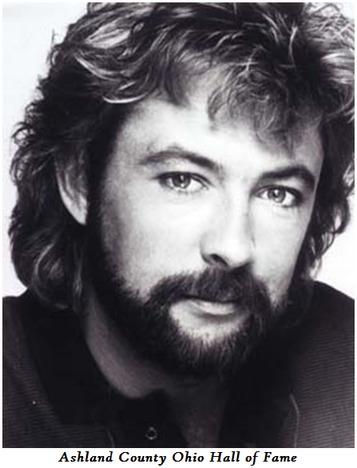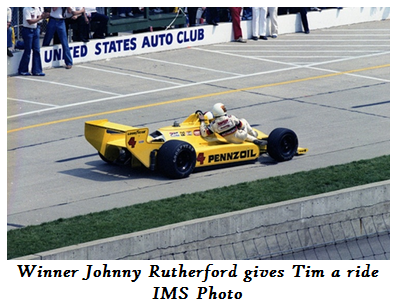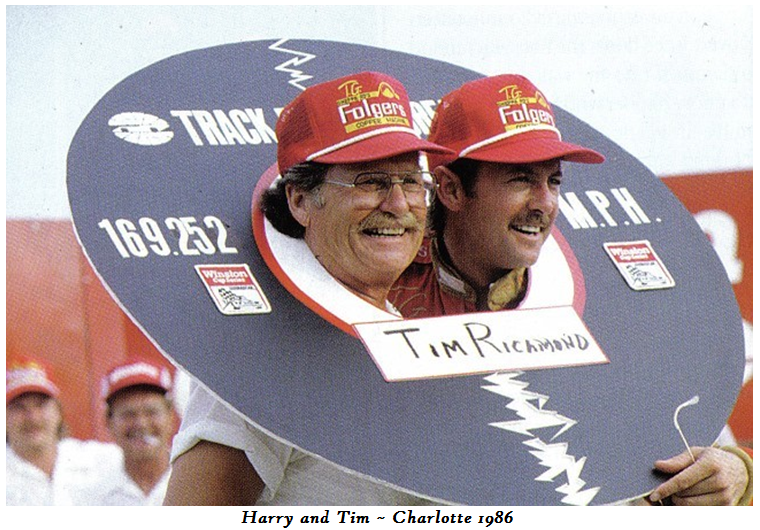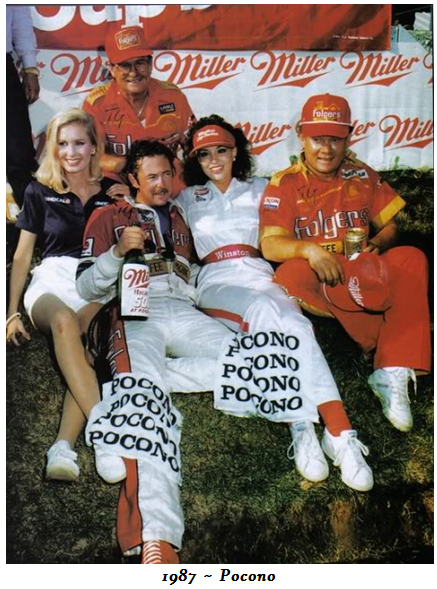Today, gentle readers, we’re going on a journey… a journey backward through time to another era… an era when things in the world of racing and indeed the world itself, were very different. The story I’ll be sharing with you is one that becomes more difficult to relate with each attempt. Time is said to heal all wounds, but each time we revisit this one, it only pains me more as the gross injustice of it all once again rises to the top and boils over in hot, angry tears.
What follows here is not all new, but then, history, if accurate, knows no change. Certainly, much has been added over the years as more was learned and more admitted. In the following paragraphs, you’ll read of the birth of NASCAR’s “famous” Substance Abuse Policy and how it was instituted for the sole purpose of bringing down a single man that dared to get sick while holding a NASCAR license. It is the story of the rise and fall, and oh, what a fall it proved to be, of one of the best racers NASCAR has ever seen. Some feel he was the best, but that point will be forever moot, as this racer died far too young to prove or disprove its validity. He died, gentle readers, 32 years ago, August 13, 1989… so long ago now that many of you reading today were not yet born then. Racers and race fans, I give you, Tim Richmond…

Tim Richmond was a NOVA: a star that burns for a short time with an intense light. When extinguished it leaves the world a darker place for it having been there.
Unlike most NASCAR Cup drivers, who get rich by driving a car and winning races, Tim was born into the lap of luxury, never wanting for anything and pretty much having everything his own way. Prep school, fast cars, fast bikes and fast women were his lifestyle. Movie stars and musicians were his friends.
This astonishingly good-looking young man never saw the seat of an actual racecar until he was 21 years old, and then it was not a stock car, but an open wheel Sprint car, belonging to a friend. It was love at first drive, as it were, and Tim had found his avocation.

He spent a few years racing Sprints and in 1980 raced the Indianapolis 500 where he finished ninth and was voted rookie of the race. After that year, feeling there were still worlds to conquer and dragons to be slain, he moved on to the stock cars of Winston Cup. Later, in explaining the difference between the two, he would state that one “drove” an Indy car, but “raced” a stock car, and race them he did, almost as if his life depended upon speed.
To say that Tim was different from those good ol’ southern drivers of that time would be akin to saying that a cat is not quite a dog. Surrounded by gruff, tough characters like Dale Earnhardt, Richard Petty and Cale Yarborough, Tim stood out like a peacock in a flock of crows. His expensive tastes in clothing, food and drink, not to mention ladies, set him quite apart from the norm, but the lad could drive!

He was not, however, an overnight success, driving one race at Pocono in 1980, for D.K. Ulrich, and spending 1981 driving a series of catch rides for several different car owners, only to face the 1982 season with no ride at all. That was cured when J.D. Stacy had a falling out with his driver, Joe Ruttman, and came looking for Tim’s services. Tim would win two races in that year, both at the old Riverside road course in California, and managed to finish 26th in points, with 7 top five and 12 top ten finishes, although he only ran 26 races.
In 1983, he accepted what would become a three- year stint with the new “Blue Max” team, owned by drag racing great, Raymond Beadle, with Barry Dodson as crew chief. Tim and Barry became the best of friends during that time, and together they shared 2 wins, 18 top five and 34 top ten finishes, along with placing 10th in the points in 1983, 12th in 1984 and 11th in 1985.
About this time, enter Rick Hendrick, who saw a world of potential in the flamboyant young driver with that proverbial fire in his belly to win races. Rick created a brand new team, ostensibly belonging to his father, “Papa Joe.” (It was some silly rule about multi-car teams, which has obviously gone by the wayside)
He built the #25 team around Tim, and especially for him, with Folgers Coffee as the sponsor, and the irascible Harry Hyde as crew chief. If you’ve ever watched “Days of Thunder”, the Harry Hogg character was patterned…loosely… after Hyde. There was a lot of Timmy in that Cole Trickle character, but one could also see a lot of Dale Earnhardt, and when it came to racing the two were not so very different.

What a shame that the new team got off to such a slow start in 1986, because before it was over, Tim would win 7 races, including both races at his beloved Pocono Raceway, and sit on 8 poles. No other driver fared as well, but a couple of mechanical failures late in the year dropped him to third in the points, behind a winning Dale Earnhardt and 6 points behind Darrell Waltrip. True to his style, Timmy had anticipated winning that trophy so much that he’d had a special tuxedo custom tailored for the occasion, along with a black and white checkered silk shirt. Although Tim never got to wear that tux as the champion, his dear friend Barry would wear it at the awards banquet in 1989, as crew chief for then Champion Rusty Wallace.
It seemed to the casual observer that 1986 was a banner year for Tim Richmond, with all the wins, the near championship and his announcement about mid-year that he had proposed to a young lady, and was awaiting her decision. (You could almost hear the collective sigh of a million or more brokenhearted gals at the thought of this handsome young devil being taken off the market) The casual observer was wrong! The engagement, much like the Championship, never materialized, and immediately after the end of the season, Tim presented himself, under a false name, at the Cleveland Clinic, to be diagnosed with auto-immune deficiency syndrome, better known as AIDS.
Over the fall of 1986 he had been noticeably ill, to the point of greatly concerning Harry Hyde, but Tim brushed it off as flu and indeed, seemed to recover for a while, only to be quite ill again by the last two races, and reportedly looked far from healthy at the awards banquet. He spent much of that winter in a hospital, and then recuperated at a Florida beach house, while we were being told he was suffering from double pneumonia and exhaustion.
One has to remember that at this time in our history the HIV virus and the ensuing terminal disease known as AIDS were barely beginning to be understood. It fell to Tim’s mother, Evelyn Richmond, to call Rick Hendrick and explain to him what the disease was, and what it would mean in the end. Hendrick was crushed and heartbroken as the full import was brought home to him and he knew he would lose his protégé and friend. Tim, on the other hand, was not easily done in, and continued to recover as he worked out to regain his strength for a comeback.

After an ill-fated outing at Rockingham in early spring of 1987, he retired once more to work harder on himself. When he finally returned to race a full 500 miles, it was at Pocono. Of course! In true Tim Richmond style, he won the race, and I’m very sure that Victory Lane still bears the stain of all the tears he shed that day. The next race was at Riverside, and Tim won that one too, with a sad but cheering Barry Dodson sitting on a hillside, watching his friend win his last race ever.
By the time Michigan rolled around in August, Tim had to be driven from his truck to the car. Sorry, I don’t recall the results of that race, but shortly thereafter Tim checked himself back into the Cleveland Clinic. Les Richter, then director of competition for NASCAR, phoned Rick Hendrick to inform him that his driver appeared to be in no shape to take to the track. It would be in September, after an announced comeback at the Southern 500 that never materialized, that Tim resigned from Hendrick Motorsports, to free the team to hire a new driver.
Now, while all this was going on, things in the garage area did not remain quiet. Anyone who follows this sport knows about the “rumor mill”, which can help or harm, cure or kill, with equal abandon, and it was in full swing! The mention of AIDS, or the possibility thereof had gotten out, and spread like a grassfire in a drought. Along with it, speculation generated more rumors, dealing with how the disease had been contracted. Some laid it to promiscuity, which it probably was, while others hinted at other causes, but by far the most damning were the rumors of drug involvement. To my knowledge, no one, to this day, has ever claimed to have seen Tim doing drugs or even talking about it, but that is the one that persisted, perhaps because its fire was fueled and fanned by no less a personage than Richard Petty. I was never sure what his problem with Tim might have been, but on more than one occasion he launched into some quite vitriolic speech for the benefit of the press and thereby, the fans.
When the Busch Clash, the first race of 1988 rolled around, Tim was eligible and wanted to drive it. It was then that NASCAR came up with one of those “on the spot” rules, supposedly instituting a drug testing policy, but somehow it only applied to Tim. Having anticipated this, Tim had stopped taking his medication some 6 weeks before. Just prior to going to Daytona, he had his own doctor run a drug screen (which was entirely clean) and seal away the results. When he arrived at the track, he requested that the test be run immediately, which was done. It was announced a couple of days later that Richmond was suspended from racing indefinitely for testing positive for banned substances.
He immediately requested and got a meeting with Richter, where he vehemently pointed out that a mistake had been made, and demanded another test, which was done. The second test was negative, but of course, the results of the first test had been given to the world. NASCAR would later admit that the only substances found in the first test were common cold remedies that most of us have taken, Sudafed and Advil! There never had been drugs or banned substances.
It was all a mistake. Eyewash! It was a carefully conceived plan on the part of NASCAR officials from Bill France Jr. on down, to discredit this man, who dared to come down with an unpopular disease on their watch. Even back then, it was all about the corporate image. Eventually, they had to lift his suspension, but still refused to let him drive without surrendering his medical records from the Cleveland Clinic, which would have proved he had AIDS. So feared was this disease then, he refused, preferring to take the secret to his grave rather than own up to it. One thing he did do, being Tim Richmond, was hire a small plane to fly over Daytona on race day, trailing a banner that read “Fans, I Miss You-Tim Richmond” We missed him too!
Later that year, Tim filed suit against NASCAR for defamation of character relating to the drug test and the false information released. NASCAR countered by demanding reams of information: Richmond’s tax returns from 1980-87; the results of every test of his urine, blood or other bodily fluids since 1980; records of every visit to a doctor, psychologist or counselor since 1980; and his medical records from the Cleveland Clinic and his personal doctor in Florida. These boys know how to fight! By fall, the lawsuit was withdrawn, once more to avoid disclosing his medical records. Rick Hendrick probably summed up all that happened in the best way. “That’s horrible to damage someone like that – to character assassinate without the facts.”
Tim retired to seclusion in West Palm Beach, Florida, where he remained, with his mother, until his death on August 13, 1989. In all those months, there were very few visitors from the “family” of NASCAR. Rick Hendrick remained close to Tim, as did Barry Dodson, but the vast majority of drivers were conspicuous in their absence, probably due to a combination of fear of the disease and fear of retribution from NASCAR. Kyle Petty offered this statement as a summation:
“It all boils down to AIDS. I don’t care what anybody tells you. Nobody knows how to handle AIDS, especially in a sport as backward-thinking on so many things as this sport is.”
For my part, I was heartbroken. This bright star went out far too early, and the hierarchy of the sport I love reacted in a manner unacceptable in the mangiest of feral hounds. As I write this, I am looking at a small blue frame, decorated with a bow in one corner, containing the words of a poem someone sent to Grand National Scene after Tim’s death. It reads
God saw you getting tired
And the cure was not to be,
So he put His arms around you
And whispered, “Come to Me.”
It broke our hearts to lose you
But you did not go alone,
For part of us went with you
The day God called you home.
We love you Tim

In front of the poem there is a 1/64 diecast of the #25 Folgers car. That’s all that remains in my life of Timmy now, except for the fact that I find it still makes the tears flow to remember all of this. Before we close today, let me share just one more thought, gentle reader. There is a very old country song whose lyrics I’ve always thought could have been written just for Tim Richmond.
“I Want to Live Fast, Love Hard, Die Young and Leave a Beautiful Memory.”
What was not made public at the time, but came to light later, was that the first drug test performed on Tim was at the hands of Dr. Forrest Tennant, not a regular NASCAR doctor, but one in the employ of the NFL, brought in by Les Richter, member of the NFL Hall of Fame… and recently “unnominated” for the NASCAR Hall of Fame. The following tiny notation appeared on page 2 of the Los Angeles Times, February 23, 1990, six months after the death of Tim Richmond.
“Tennant No Longer NASCAR’s Drug Adviser”
“Dr. Forest Tennant is no longer working for NASCAR as its drug adviser, a spokesman for the premier stock car sanctioning body said Thursday in Daytona Beach, Fla.
Tennant is the executive director of Community Health Projects, Inc., a group of drug-treatment clinics headquartered in West Covina.
He has come under fire for his work as a consultant to the NFL, and it was reported this week by The Times and WJLA-TV in Washington that the result of a drug test he administered to Tim Richmond was falsified. Richmond, a former Winston Cup driver, died of AIDS last August.”
And that, gentle readers, is how NASCAR’s substance abuse policy was born, and why your scribe has always harbored ill-feelings for it. Anything that can be so twisted and manipulated to harm, degrade and defame a man guilty of absolutely nothing, is not to my mind a good thing, and a pox on all those responsible for doing so.
IF… and it’s a big IF, Tim hadn’t been made to feel so ashamed of the disease he’d contracted that he went off his meds for 6 weeks before taking a drug test, it’s quite possible he might still be alive today. In doing that, he let his immune system sink to zero defense, and never recovered. Today, many folks with AIDS are living long lives, not without worry and complications to be sure, but living. If his dignity had been left intact by the hierarchy of NASCAR, he well might be too, and THAT is the saddest part of the story.
Please note, this was not done by “NASCAR.” That is merely a corporate acronym. No… this was done by human beings… and you… those of you still living… each know who you are. How do you sleep at night?

Just close your eyes and let Diamond Rio take you wherever the road leads as you listen to “One More Day”, then open your eyes and read along as overlaying the music are the words to a poem called, “The Last Time.”
Be well gentle readers, and remember to keep smiling. It looks so good on you!
~PattyKay

(Editor’s note: This story is publish with the permission from the author! It was originally published on RaceFansForever; )



What NASCAR did to Tim was very wrong. You said so much to remind us how they could manipulate things if they are afraid of what is happening, mainly because they don’t know or understand things. About Richard Petty, I had always liked him until then. I believe he was jealous and did not like someone else being as popular. When he came out and talked about drugs possibly without any proof, he convinced many people it was true. I know I never cheered for him again after that. Tim died a horrible death and did not have many people he had known and associated with prior to this, support him when he needed it most. My heart breaks all over again at how all of this happened and I will never be ashamed to say I still shed tears. This article brought them to my eyes again. Thank you